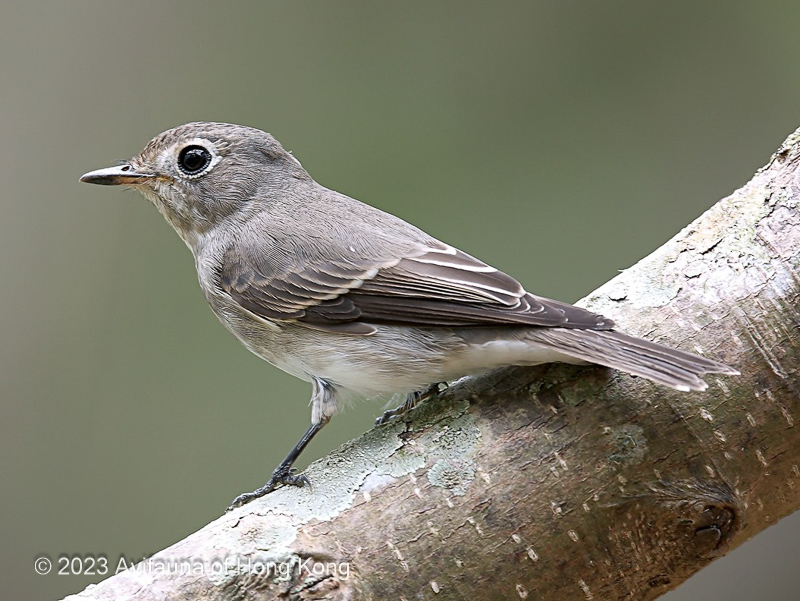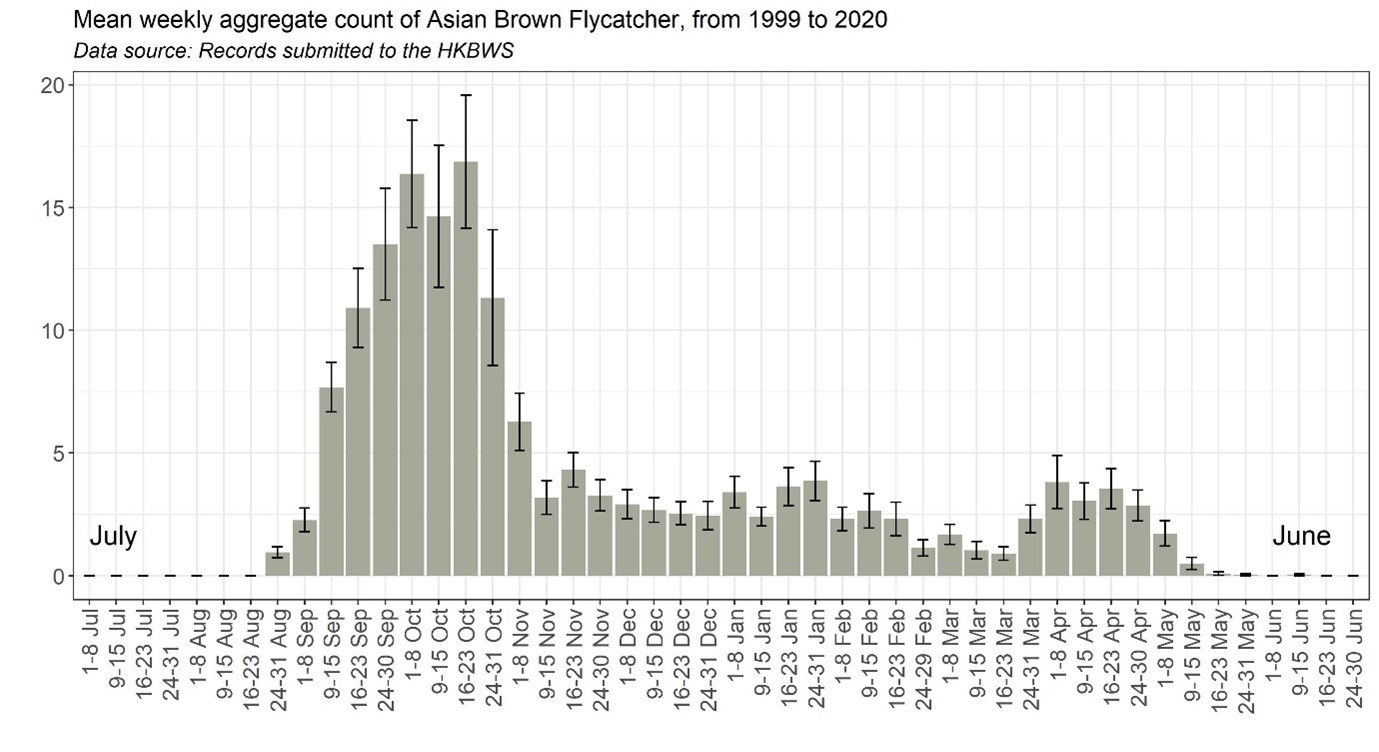Asian Brown Flycatcher Muscicapa dauurica 北灰鶲
Category I. Common passage migrant, more numerous in autumn than spring, and winter visitor; occurs wherever there are suitable trees .
IDENTIFICATION

Sep. 2013, Dave Diskin.
12-14 cm. Small to medium-sized, large-headed short-tailed flycatcher. Sexes alike. Head and upperparts greyish-brown. Conspicuous white orbital ring and pale lores, sometimes with dark submoustachial and lateral throat stripes. Broad-based bill with yellowish base to lower mandible. Wings and tail dark brown, breast and flanks pale greyish-brown (sometimes a weak breast band is apparent), throat, belly and undertail coverts white. Adult has narrower and greyer fringes to these feathers.

Oct. 2008, Michelle and Peter Wong.
First-winter birds have more prominent whitish fringes to greater coverts and tertials.
Other features distinguishing from Grey-streaked Flycatcher and Dark-sided Flycatcher include shorter primary projection (shorter than exposed tertials) and usually the lack of obvious retained juvenile feathers (Leader 2010).
VOCALISATIONS
Two calls are commonly heard. The first is a short dry thin rattle that falls in pitch .
The second is a high-pitched metallic ‘sip’.
DISTRIBUTION & HABITAT PREFERENCE
Recorded from widespread sites with sufficient tree-cover for migrants and winter visitors, including parks in urban areas. Although the percentage of 1km squares in which this species was recorded was little changed between the 2001-05 and 2016-19 winter atlas surveys, there were fewer birds recorded in the Tai Mo Shan massif and HK Island in the most recent survey, possibly due to expansion in area of closed-canopy forest area.
OCCURRENCE
Asian Brown Flycatcher is a common passage migrant, more numerous in autumn than spring, and winter visitor. Extreme dates are 26 August and 27 May; in addition, a bird was photographed on 12 June 2010 on HK Island.
The first autumn birds usually appear in during the first half of September (Figure 1). Peak migration takes place during the second half of September and October; 52% of records from 1999-2020 occurred between 16 September and 31 October. Numbers decrease gradually from November to the third week of March, while an increase from the last week of the month is evidence of passage through HK. This continues through April but drops off substantially during the first week of May. April sightings only account for 8% of annual records, which illustrates the relative weakness of spring passage compared with autumn. There appears to have been little change in this pattern since 1958.
The sum of weekly counts by season shows an increase from 64 birds in 1999/2000 to 345 in 2019/20. This increase in numbers appears largely due to an increase in observer activity. Indeed, Carey et al. (2001) suggested that numbers of this species were declining in HK, citing a lack of high peak counts in the 1980s and 1990s. In support of this, the highest counts on record are 25 at Fanling Golf Course on 30 October 1977 and 40 at Mai Po on 18 October 1959. However, during 1999-2020 the highest count was 20 at Mai Po on 13 October 2015 and reached double-figures only in five years.
First recorded in Hong Kong by Vaughan and Jones (1913) who regarded it as the most abundant of the flycatchers on passage, occasionally wintering, as is the case today.
BEHAVIOUR, FORAGING & DIET
Usually observed singly, although on occasion during peak migration several birds may be found in the same general area indicating some birds may migrate in flocks.
It hawks insects from branches of trees and bushes and may return to the same perch but does this less frequently than Dark-sided Flycatcher. If temperatures fall below 10⁰C in winter, it can be seen on the floor of drainage channels or at the base of trees searching for insects on the ground.
SYSTEMATICS & RANGE
The species occurs in India east through southeast Asia, the Greater Sundas and the Philippines, and north through China to northeast Asia.
The nominate race migrates from its breeding grounds in northeast Asia to wintering areas in southern China, including HK, and southeast Asia. It breeds in central Siberia and southeast Russia, northern Mongolia, northeast China, North Korea and Japan. It winters in south China, southeast Asia, the Philippines and the Greater Sundas. In China it breeds in Inner Mongolia, Heilongjiang and Jilin. Migrants occur throughout the eastern provinces and wintering birds can be found in Fujian, Guangdong, Guangxi, south Yunnan and Hainan (Liu and Chen 2020).
Two other subspecies are recognised by the IOC. M. d poonensis occurs in the Indian subcontinent, and M. d. siamensis is resident in south Myanmar, west and northwest Thailand and south Vietnam (Clement and Bonan 2020).
CONSERVATION STATUS
IUCN: Least Concern. Population trend stable.
Figure 1.

Clement, P. and A. Bonan (2020). Asian Brown Flycatcher (Muscicapa dauurica), version 1.0. In Birds of the World (S. M. Billerman, B. K. Keeney, P. G. Rodewald, and T. S. Schulenberg, Editors). Cornell Lab of Ornithology, Ithaca, NY, USA. https://doi.org/10.2173/bow.asbfly.01
Vaughan, R. E. and K. H. Jones (1913). The birds of Hong Kong, Macao and the West River or Si Kiang in South-East China, with special reference to their nidification and seasonal movements. Ibis 1913: 17-76, 163-201, 351-384.
Leader, P. J. (2010). Brown, Siberian and Grey-streaked Flycatchers: identification and ageing. British Birds 103: 658-671.
Liu, Y. and Y. H. Chen (2020). The CNG Field Guide to the Birds of China (in Chinese). Hunan Science and Technology Publication House.

